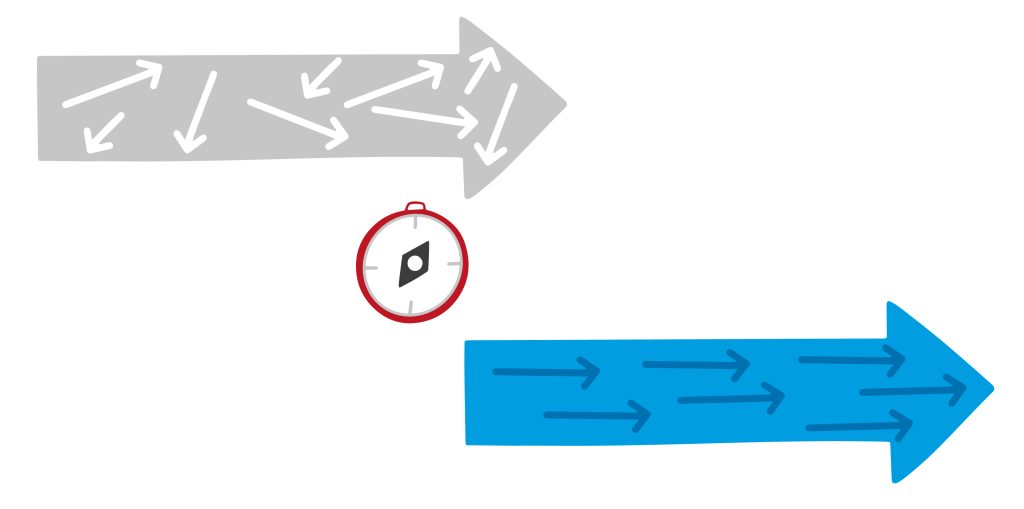OKRs for alignment and focus
Alonso Alvarez
Life for organizations in general and companies, in particular, has never been easy. However, this 21st century poses unprecedented challenges. Organizations must keep people aligned to a strategy, focus on what is essential, and operate with the flexibility and speed of small startups, even if they are large corporations. These skills (among others) are critical for thriving and even surviving in the world (VUCA or BANI) that we live in.
In aligning the organization towards a specific goal, focusing on what is important, and reducing distractions, the OKRs framework (Objectives and Key Results) is the most adopted technique by organizations.
OKRs were born in Intel in the 1970s by the hand of Andy Grove. There was when John Doerr, who has contributed most decisively to popularizing OKRs, met them and later introduced them to Google in 2000.
It was a solution to the company’s growth problems, especially the lack of alignment of initiatives with its strategy and the dispersion of focus in its activities. The framework impressed, and it was adopted as a mechanism for setting objectives. Over time, an increasing number of organizations have incorporated OKRs into their operations.
What are OKRs?
There is no magic in OKRs. They are what we have already mentioned: objectives and key indicators. They are a simple mechanism, yet they are very effective in practice.
On the one hand, we have a -limited- number of Objectives that set out with a qualitative vision of where we are going. These objectives must be easy to understand and remember. They should align with the overall purpose of the organization. They are also expected to be aspirational. This means that they point to a goal that may not be possible to reach for now.
Each objective is accompanied by a limited number (usually 3 to 5) of Key Results (KRs). If the goals tell us where we are going, the Key Results will tell us if we have reached them. That is why they are expressed quantitatively and must be measurable, clear, time-bound and actionable. Whoever is involved in achieving the Objective and will use the KRs as a measure of having achieved it must influence it.
KRs must be primarily outcomes or results, and not only outputs. This makes them genuinely key results relevant to the achievement of the set objective.
OKRs are established with time horizons that favor adaptation. They are usually set and reviewed every three months (OKRs for the organization as a whole can be set annually). More frequent monitoring allows for greater adaptability to change while helping to refine the way we implement OKRs, generating new learning opportunities.
If this sounds too vague, let’s take a better look at an example:
We create an OKR whose objective is to “Introduce OKRs in the company.” We are talking about a global goal, so it will be developed throughout the year.
To carry it out, we define three KRs to help us determine whether it has been achieved:
- A percentage above 80% of people trained in theory in the first quarter.
- Availability of quarterly OKRs in the assigned groups.
- Quarterly review in groups applying OKRs
How do OKRs compare with other mechanisms, such as KPI-based target setting? OKRs define not only the what but also the how. Their focus is the achievement of objectives rather than monitoring. They are ambitious and aspirational, shunning risk aversion, so they cater better to the progress and growth of the organization and people. Their focus is on motivation rather than performance evaluation.
OKRs and alignment
OKRs are established at the different levels required by the organization. At the highest level, OKRs are the way to translate the company’s strategy into a set of objectives that facilitate its implementation. The remaining levels define how to support the global OKRs, defining more concrete and limited OKRs: for areas and departments, teams, and even individuals.
This process translates the organization’s strategy into something exact and limited so that all participants know exactly how they can contribute.
In this way, the organization has the same objectives, grounded in the scope of action of the levels involved. The steps taken to achieve the goals are a way of implementing the strategy. In this way, the entire organization is aligned towards the same end.
As the strategy is often expressed in a broad and imprecise way, OKRs provide a mechanism that helps to concretize and implement and facilitates the alignment necessary to achieve the goals.
OKRs and focus
If we already suffer from a worrying attention deficit in our personal lives, it is multiplied and is one of the tremendous current challenges in companies. Concentrating on a few relevant and valuable actions is one of the levers for achieving strategic objectives. Here again, OKRs can help.
By limiting their number to a maximum of 3 to 5 Objectives per level (company, area, department, team, individual, …), we limit the distractions that could jeopardize the achievement of the proposed goals. By revising them more frequently than traditional objectives and KPIs, we avoid focusing on actions that have lost their validity.
In this way, OKRs help organizations align and focus their activities, review their objectives periodically to facilitate adaptation to a changing context, be ambitious with inspiring goals, and generate more significant commitment from people with a participatory OKR definition process.
All in all, we have a model that helps maintain the most desirable characteristics of companies like startups (adaptability, focus, commitment, closeness) in much larger organizations.
Learn more about OKRs
To better understand what OKRs are, knowing the cycle into which they are set and reviewed is necessary. It will help to understand their impact on people and organizations and how they benefit companies that have adopted this framework. But that will be covered in a future article.
Another way to learn about OKRs is to watch Natalija Hellesoe‘s outstanding presentation at the last Adaptive Organization Week, organized by Netmind, where she talks about the challenges of using OKRs, and possible solutions to put this framework into practice.
https://youtu.be/NzTZ7v5dVjE
Full video presentation
Download presentation PDF


